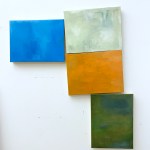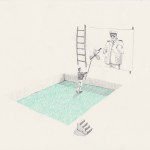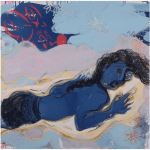
Readers may recall that last May I held a public conversation with Peter Soriano on the occasion of his installation, �Permanent Maintenance� at the Colby College Museum of Art. Hosted by Skowhegan, we talked about Soriano�s process and the site-specific piece at Colby, which was inspired by the campus grounds and a three-part Richard Serra sculpture that is installed outside the museum. This month, Soriano has created three immersive murals and related drawings at Lennon, Weinberg, on view through October 22. The most ambitious work in this outstanding exhibition is informed by the changing shapes of shadows cast by the roofline of the artist’s house in Maine.

In a wonderful catalogue essay for the exhibition, Jill Weinberg explains the process and puts Soriano’s work in context:
At intervals, over a period of six months last winter and spring, Soriano staked the corners of the geometrically complex shadows and measured the distance of each from the house, then recorded the information necessary to recreate the shapes. He is intrigued, he says, by the seeming contradictions of shadows: immaterial yet concrete, describing as they do a physical relationship between object and plane. From his point of view, the house became a sort of sundial, the cast shadows marking increments of time.
When he began creating Shadows (Penobscot), Soriano decided to reference the clapboards of the house with parallel horizontal lines, and inserted circular �portholes� inside of and around which he would describe the shadows under observation. He composed the work�from left to�right,�largely without preparatory drawings,�allowing it to unfold chronologically as�the seasons�advanced and the angle of the sun changed. Come spring, for example, as the morning sun caught a bit of the north side of the house for the first time, he indicated thatdetail with sprays of bright yellow in the concluding section of the finished work.
In�Synthetic Contrivance, under the skylight in the gallery,�Soriano�takes as�his�subject the shadows cast by�his wife�s clothes strewn on a bench�but in this case the light is artificial�and static,�captured in a single moment�late one night.�In its examination of�shadows�from multiple viewpoints, Synthetic Contrivance�is�cubist�in spirit.�Beat-Up Subject, installed on the gallery�s west wall, revisits the shadows cast by the house in Maine, this time over a period of just three days in July. It is a reductive, diagrammatic work in which a viewer can decipher the contours of the shifting shadows, and perhaps puzzle out their connections to the schematic representation of the house. (The title is borrowed from Stuart Davis, who used the phrase to describe a well-used compositional motif.)
After completing each of these works in his studio, Soriano measured and photographed the compositions, and wrote precise guidelines for re-installation. He executed the original wall drawings by himself, but intends that future iterations are equally authentic regardless of his participation, in the way that a composer writes a score to be performed by others, or that anyone can create a Sol Lewitt wall drawing simply by following his written instructions. Indeed, this exhibition was created by a small team of experienced and novice installers working alongside the artist over seven long days.
These seemingly rational processes of Soriano�s wall drawings�the many measurements, the careful notes�yield results that are anything but rational. The works do not provide an apparent rationale for the viewer to derive meaning from the purported subjects, nor do they suggest that his inquiries could possibly lead to any useful conclusions. The finished works are as spontaneously unmoored as Eva Hesse�s latex-coated ropes, as paradoxical as Robert Smithson�s pseudo-science rocks and mirrors, as obdurately willful as Philip Guston�s paintings and as subjectively felt as Joan Mitchell�s translations of landscape into abstraction. Each of these artists is a distinctly different seminal influence on Soriano�s approach to creating visual manifestations of internal states of perception.
Peter Soriano is a sculptor who no longer makes concrete objects, but already present in his early work was an affinity for the gap between a proposal of functional purpose and aesthetic resolution. His signature cast resin sculptures of the 1990s might resemble a sled, a bumper car, a cartoon sphinx or a mechanical part. They were colorful, ebullient, pop-inflected confections that gave way a decade ago to elusive exhumations of memory of inhabited spaces through irregular plywood box shapes and installations involving aluminum tubes, cables and turnbuckles anchored to walls and articulated with spray-painted dots, dashes and arrows. In the end, he decided that the physical components were getting in the way of his quest for metaphorical content and let go of the last vestiges of conventional sculpture in his work. He has set his sights on a liminal terrain in which his complicated, abstruse and challenging work might find harbor in a space between thought and feeling.








The murals conjure the type of illusion that Fred Sandback created with string, imparting�the theatricality and presence inherent in monumental sculpture.�Soriano’s singular achievement is to go a step farther by eliminating the physical component of the medium.�Standing in the gallery, I felt as though the walls were disappearing and the color-coded lines were floating in space. �
“Peter Soriano: Three Murals and Related Drawings,” Lennon, Weinberg, Chelsea, New York, NY. Through October 22, 2016.
Related posts:
Catalogue essay: Kirsten Swenson on Peter Soriano�s Permanent Maintanence
Art and Film: Eva Hesse�s enduring disruption
Rockburne�s mural-making at the Queens Museum














